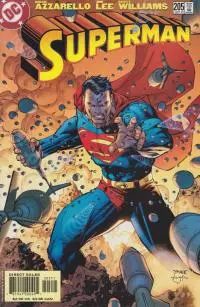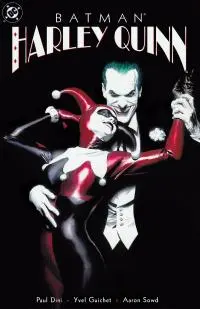The DC Extended Universe started with 2013’s Man of Steel, but with the release of this year’s Batman v Superman and Suicide Squad, it’s clear these are only loose adaptations of the comic book source material. That being said, are these iterations valid? Because the intriguing thing about this shared universe, the brain child of screenwriter David Goyer and directors Zack Snyder and David Ayer, is that it is true to its roots in an unexpected way.
The “pregnant moment” is a striking visual that implies the climax of an entire story in just one static image. Mostly covers, of which there is a long history of misrepresentation for the sake of salesmanship, but also individual panels have taken on a life of their own and are recreated in a semiotic round robin. It’s as if Warner Bros., with the DCEU, is only adapting the popular imagery of DC Comics, imagery that more often than not is arresting but contrary to the story.
There are three images that exemplify the iconography from which the DCEU is reverse-engineered: Batman holding a machine gun on the cover of Detective Comics #710 (1997), drawn by Lee Weeks and Patrick Martin; the cover of Superman #205 (2004), by Jim Lee, of the titular character sporting glowing red eyes while bullets fly toward him; and the cover of Batman: Harley Quinn #1 (1999) by Alex Ross, known as “Tango of Evil”, depicting Harley Quinn and the Joker entwined in a dance.
The “pregnant moment” is very common in commercial advertising: as Janet Odgis, President and Creative Director of New York-based branding firm Odgis + Co. explains in The Huffington Post, ‘some of the best branding relies on tension and a sense of anticipation—the creation of what one might call “the pregnant moment.” When the audience senses that something big is in the works, they pay attention.’
And, of course, this is a vital element in the creation of the movie poster. Writer/director Clive Barker sums this up perfectly in an interview with Paul Wells: “I didn’t really see the Hammer [Horror] pictures until I was eighteen, but I saw the posters, and the posters were more of a major influence on me than the movies. Somebody told me that, in some cases, they actually designed the posters before they made the movies! I think [Roger] Corman did the same thing—it’s a great marketing and continuity ploy, and the posters certainly attracted my attention.”
The pop art sensibility of movie posters is in line with comic covers: both are previews but can also be shallow and misleading. They summarize theme and content, but also tantalize. In that way, a cover captures the essence of the pages within, and consequently comes across as the artist taking inspiration only to create their own tangential pregnant moment.
Take Detective Comics #710. Batman is in a tense battle with Deathstroke, the famed assassin, who wants to kill the gun-toting maniac known as Gunhawk. Ultimately Batman gains the upper hand and utilizes Deathstroke’s sniper rifle to fire upon Gunhawk, knocking the weapons from the man’s hands so police can move in. In the end, Batman explains, “Under Henri Ducard’s tutelage I mastered long-range sniping. I hated using a gun then. I hated using one tonight. But what I hated most of all is how close I had to come to that last resort.” The entire issue, written by the long-tenured Chuck Dixon, functions as a walking back of the cover and an affirmation of the Dark Knight’s hatred of fire arms.
The cover is in reference to a famous panel from Frank Miller’s The Dark Knight Returns. There Batman, with no other choice, utilizes a machine gun to wound a criminal who has a hostage. In fact, in The Dark Knight Returns the Batmobile is only armed with rubber bullets, and most damning is Batman breaking a shotgun over his knee while declaring, “This is the weapon of the enemy. We do not need it. We will not use it.”
 So why have Batman, who is popularly depicted as hating guns, use a gun? Certainly Miller, who also has Batman firing a grappling hook from a sniper rifle in The Dark Knight Returns, must have been aware of this tension and played against audience expectations in order to shock. But the unfortunate side effect is it cemented an image. From that point on, from Tim Burton to Zack Snyder, the idea of a gun-toting Batman is irresistible. Even Christopher Nolan, who doubled down on his version not killing, plays to this with the rifle that fires plastic explosives in The Dark Knight and the EMP gun in The Dark Knight Rises.
So why have Batman, who is popularly depicted as hating guns, use a gun? Certainly Miller, who also has Batman firing a grappling hook from a sniper rifle in The Dark Knight Returns, must have been aware of this tension and played against audience expectations in order to shock. But the unfortunate side effect is it cemented an image. From that point on, from Tim Burton to Zack Snyder, the idea of a gun-toting Batman is irresistible. Even Christopher Nolan, who doubled down on his version not killing, plays to this with the rifle that fires plastic explosives in The Dark Knight and the EMP gun in The Dark Knight Rises.
The difference is that when Snyder and his screenwriters created Batman v Superman and carried over scenes and dialogue from The Dark Knight Returns wholesale, they learned the wrong lessons. The hostage scenario, for instance, is recreated in Batman v Superman almost identically, except instead of shooting to wound Batman fires into an assailant’s flameflower, igniting the fuel and killing the man. If comic covers create an expectation the comic itself refutes, the DCEU strangely enough does the opposite and embraces the popular conceptualization to an extreme degree.
The same is true of the 21st century image of Superman, starting with Jim Lee’s reframing of the character during “For Tomorrow”. Written by Brian Azzarello, known more for hard-edged crime fiction like 100 Bullets at the time, it tells a somber story of Superman intervening in the Middle East to retrieve a Kryptonian weapon of mass destruction. The device is accidentally activated, causing half the population of earth to disappear. This fusing of an exigent real-world topic (the wars in Afghanistan and Iraq were in full swing, and WMDs became a household name) with the fantastical was a unique take. Lee, known for his sharp and sexy work at Marvel on X-Men before co-founding Image Comics, also wasn’t an artist associated with Superman. Fresh off Batman: Hush, his extreme and grimdark look set a precedent for the Man of Steel.
#205 sees Superman tracing the source of the disappearances to a civil war battleground. He destroys all of the weapons on one side, but is surprised when a little boy picks up a rock and flings it at him. Human beings always find a way to hurt, and it’s not Superman’s place to intervene. This is in stark contrast to the cover that shows Superman mid action shot (replicating The Matrix’s “bullet time” effect) in what can only be described as a “badass” pose. His eyes about to erupt, muscles pulsing, this is a angry, powerful being that tears through any threat. Much like Detective Comics #710, however, the interior contradicts this image, with Superman hovering above the violence.
The origin of this recontextualizing of the Big Blue Boy Scout into pissed-off bull in a china shop can be traced to “For the Man Who Has Everything”. The classic story, written by Alan Moore and published in Superman Annual #11 (1985), sees Superman unleashing his heat vision on the alien warrior known as Mongul, commanding the tyrant to “Burn.” It’s an eye-catching image, accompanied by panels of Superman screaming and crashing through walls with set jaw and clenched teeth. But again there's power in context: Mongul trapped Superman in a fantasy in which Krypton never exploded. It was his ideal dream, but to learn it wasn’t real angered him like nothing before. Mongul is also an opponent like nothing Superman had faced, a physical foe that can stand up to a might that can move planets. So this was a rare occasion, heightened all the more by its rarity.
 The Superman of Man of Steel and Batman v Superman, however, responds to every situation like this. Years of being bullied filled him with repressed anger he must unleash. This results in wrapping an offensive truck driver’s semi around a pole, or impulsively barreling General Zod into a populated downtown Smallville. In BvS he reasons with Batman initially, but allows a scuffle to ensue. It's not a battle at first, because Superman can’t know that Batman will even the playing field with Kryptonite. So flinging Batman 100 feet and smashing him through a building is indulgence for a man that can fly into space and hold up oil rigs. All the while he bellows and grimaces, muscles bulging and eyes erupting with energy that more resembles napalm than lasers. Wonder Woman even muses that he’s remembered as a soldier, whereas the first six decades of the comic book iteration would try to avoid a fight at all costs.
The Superman of Man of Steel and Batman v Superman, however, responds to every situation like this. Years of being bullied filled him with repressed anger he must unleash. This results in wrapping an offensive truck driver’s semi around a pole, or impulsively barreling General Zod into a populated downtown Smallville. In BvS he reasons with Batman initially, but allows a scuffle to ensue. It's not a battle at first, because Superman can’t know that Batman will even the playing field with Kryptonite. So flinging Batman 100 feet and smashing him through a building is indulgence for a man that can fly into space and hold up oil rigs. All the while he bellows and grimaces, muscles bulging and eyes erupting with energy that more resembles napalm than lasers. Wonder Woman even muses that he’s remembered as a soldier, whereas the first six decades of the comic book iteration would try to avoid a fight at all costs.
Finally, Batman: Harley Quinn #1. Released during the height of the “No Man’s Land” crossover event, it was written by Quinn co-creator Paul Dini. The character, of course, debuted on Batman: The Animated Series in 1992, so it was fitting that Dini oversee her transition into comic book continuity. The duo have been up to their chaotic antics for a few weeks, but Joker decides Harley has been bringing out emotions in him long since buried. He attempts to kill her by trapping her in a rocket, of all things, but she escapes. In the end she’s about to kill him, but he apologizes and she relents. They embrace in silhouette, apparently kissing.
That’s definitely in line with the characters’ more than 20-year relationship, with the Joker abusing Harley and only allowing physical affection when necessary to nurture Harley’s Stockholm syndrome, but the cover begs to differ. The Ross painting shows them mid-dance, suggesting a mutual intimacy rarely if ever portrayed between them. If the Joker and Harley ever hug or kiss, it’s generally her as aggressor and he almost always responds with rebuke, from punches to kicks and exploding whoopee cushions. But to see this image, maniacal as they are, is to see a couple in love and on equal terms. They’re star-crossed killers, a regular Mickey and Mallory, a fascinating choice considering their coupling on paper is Joker plays hard to get and may harbor a homosexual attraction for Batman.
But Suicide Squad suggests writer/director David Ayer's starting point was the Ross painting. There’s no reluctance on Joker’s part, as he actively attempts to save Harley throughout the movie in a way that goes against his usual self interest. There’s no abuse, as he never once raises his hand to her in violence. And there’s definitely multiple kisses and implication of sex that cackles in the face of any homoerotic subtext. There is, however, a brief flashback to a recreation of the cover of Batman: Harley Quinn #1, the only time Quinn is glimpsed in her classic costume.
Again, it’s not that these aren’t necessarily valid takes on adapting DC Comics into their own shared cinematic universe. There’s precedent of these covers capturing the essence of and summing up the popular idea of a character in “pregnant moments” that tell their own stories. But there’s also a conversation that goes on between covers and comics in which expectations are created and either met, but with a twist, or subverted. To work backwards from these covers is to suggest a surface-level understanding and concern more for what’s cool rather than what’s nuanced. That’s not the way to tell good stories, and that’s not the way to build a universe.

About the author
A professor once told Bart Bishop that all literature is about "sex, death and religion," tainting his mind forever. A Master's in English later, he teaches college writing and tells his students the same thing, constantly, much to their chagrin. He’s also edited two published novels and loves overthinking movies, books, the theater and fiction in all forms at such varied spots as CHUD, Bleeding Cool, CityBeat and Cincinnati Magazine. He lives in Cincinnati, Ohio with his wife and daughter.







